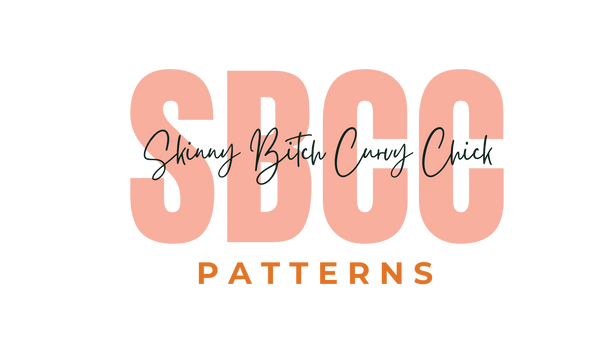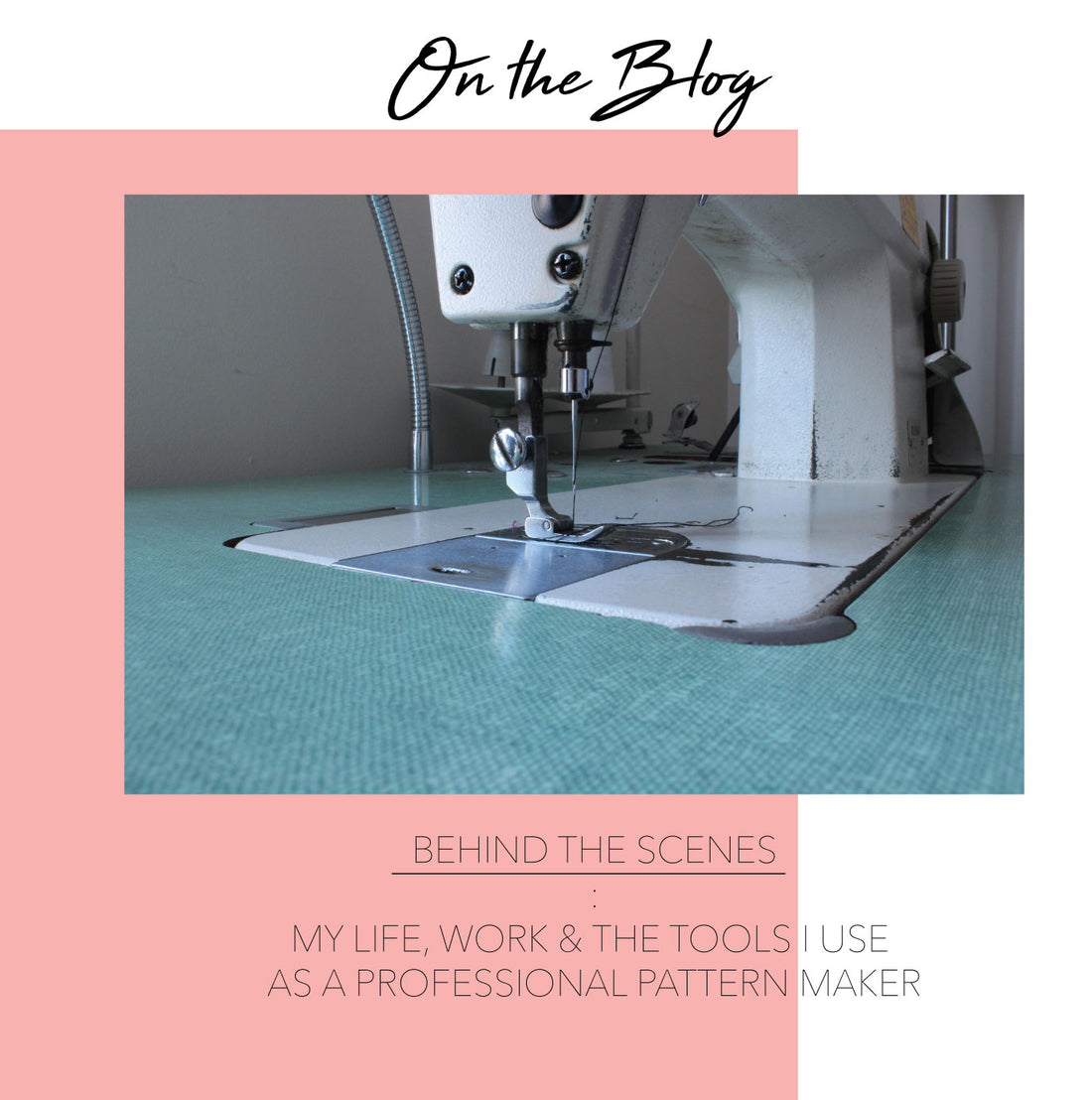
Sometimes you won’t hear anything from me for quite a while. Dead silence on the website, social media, and my email response time is a little delayed.
Then, without warning, I’ll add another pattern to the store, celebrate for a bit and drift off into the sunset again. Social media accounts have the feeling of an abandoned summer home covered in dust sheets. They are all patiently lying in wait for my return to offer something new, exciting or insightful. I too look forward to new patterns and I have so many ideas that my head is exploding and constantly building big plans for new stuff to come.
The guilt runs deep in regards to what I am able to do with SBCC, but instead of making excuses and leaving things hanging I figured it was probably about time to invite you to my world as a professional pattern maker and to take you on a tour of what I do, show you around my workspace, and the tools I use.
The Type of Work I do
I exist in this weird place because I'm pretty much the epicenter of secret projects. I get to do a ton of fun stuff for amazing clients, but I just can't talk about them or who they are for. So apologies in advance if you are looking for juicy gossip- my lips are sealed :)
I wear a lot of hats, but to sum up the scope of my work I'm a professional pattern maker and grader for large retailers, small independent designers, and other home sewing pattern companies. (To answer a common Q and get it out of the way- yes, I have worked with Project Runway winners- I'm not saying who exactly :) ). My work is a passion project. I love bringing ideas to life and fine tuning for mass production. It’s a ton of work though, as it is very detail oriented and demanding, hence the disappearing act. I also consult on the technical side of apparel mass production, dealing with snafu's, mishaps and basically fashion triage for "oh-S&%T!" moments- Like, how to deal with 2,000 jackets that have been shipped from overseas, delivered and unboxed to find the wrong labels sewn into them (SMH!)
My Clientele
I don’t do glamorous, high end, avant- garde fashion (Ugh, I hate working on gowns or bridal!). While it is beautiful it’s not my niche. As a pattern maker, I learned early on that the best paying jobs with good hours and benefits come from mass-market sportswear (at least in NYC). Definitely not runway caliber, but I’m willing to bet that you have probably owned a garment that I have worked on at some point in time.
This kind of retail base taught me how to run a really tight ship for production and quality assurance. (The bigger the retailer the tougher the standards.) I regularly have to sign off on using my patterns to cut 10,000+ pieces for million dollar investments. It can be a bit nerve wracking, but being in a factory and seeing racks upon racks of a single item I have worked on is a pretty awesome feeling.

On the other end of the spectrum, I work with small labels. Clients who might not have done a full-scale production run before or those looking to take their one-person show and kick it up a notch to reduce the workload. I love my small biz clients. They are the most passionate, dedicated, and innovative. It feels awesome to help them do well and watch them grow!
I also work with home sewing brands for primarily grading, ie- creating all the sizes. I really enjoy grading - maybe too much. Pattern making is creative, but grading is like putting together a 1000 pc jigsaw puzzle in one sitting. Maybe that doesn’t sound like your sort of thing. I’m just OCD enough to get into the zone and keep going until it’s finished. (If anyone is interested in how I do this, maybe it merits a post for a later day.) However, you can check out how I explain the process to clients here.
Where I Work

Let me just start out by dispelling the romantic view that I work in a huge well-lit space surrounded by large cutting tables, sample sewers and machines all around, oak tag patterns on rolling racks and beautiful fabrics.

Nope, that’s definitely not me. I live across the water from NYC where rents are super high and industrial spaces are hard to come by without a major investment. I work out of a second room in my apartment because it’s the most comfortable and affordable for me. Would I like more space? Absolutely! But perhaps someday.


It’s all about being compact and maintaining a nearly total digital environment. I print out or email patterns, but I don't keep hard copies around (notice, I have no tables at all, just a fold out one in the living room for sewing projects). This means a lot of equipment though. Professional sample making projects are outsourced so this also keeps my space pretty clear.
But what about sewing space? Mr. SBCC sourced some computer arms to help me move my monitors and collapse my keyboard if I need to sew anything. This is a huge space saver.

My computer chair is rather ugly. It’s comfortable, though, and saves my back and neck after long hours at the screen. Bonus, it has a foot rest that comes out which I pull out for when I am really in for the long-haul of all day pattern grading.

I have a PC which I need to run my drafting and marker program (Optitex). I keep my Mac laptop handy for emails and Adobe Illustrator. I don't know how I ever lived with only one screen before! **Pattern on the screen is the Tonic Tee, to give you an idea of how all patterns start out looking.

The sewing Machines:
Straight-Stitch - An industrial Juki I inherited for free. It’s a little loud but it gets me by. My next purchase/hunt is for a used newer model with a silent servo motor.
Overlock - I have a Juki 2-in-one for coverstitch and overlock. However, the coverstitch is very poor on this machine. (Sewing repair guys have confirmed this is inherent in this product; FYI for anyone thinking to buy this.) I only use it for overlock and it's decent.
Coverstitch - Because the table top Juki was no good and too tedious to switch back and forth quickly I recently purchased my Juki industrial coverstitch. It looks a little frightening, but it's rather docile.

When I have to drape something or a designer wants their hard copy patterns made digital, I use a digitizing mat. I can tape muslins or patterns to the mat and It translates the shape back to my software based on points I define. It’s a roll-up and I can store it in the closet when not in use.

Printing is a big deal and my equipment have been my biggest purchases thus far. Some of my clients have their own capabilities to print digital files that I email them. However, others don't because it's a huge expense and plotters take up a lot of space. The plotter below lives in the living room. I print all of the SBCC patterns off of this and single styles for pattern development because it's quick and easy.

The larger plotter, shown in photo earlier in post, is my latest and greatest. This one is a critical piece for me because it can print markers which are used for cutting layout guides for mass production. Markers need to be as wide as the fabric so the plotter needs to be extra wide (more on markers in a later post I am working on). She was custom built for me in the US and is super silent and slick.

I used to collect more books, but now I focus on data and resources. I have binders full of random bits of info I have collected over the years and I go back to these more than books. Sidenote- No drafting books will be found here except for random inspiration of shapes or sentimental reasons. I hate drafting formulas and have yet to find anything that gives a remotely similar outcome to what I have done for mass production. Just wanted to toss that out there for anyone who struggles with drafting.
You've probably already seen photos of the mannequin gang as they are frequent photo props. My dress forms cover size 18W, 18W petite, size 4 and size 8. I only use these occasionally, as I don’t do a ton of draping work. I use them mostly for fit review or to hang projects off of.

The Fabric Stash AKA Pit of Misery - (I can't even show you a pic, it's so bad!) I really try not to hoard fabric, but it happens. I get a lot of stuff for free as it would be discarded otherwise. (It would be wasteful to turn it down, right?). This is looking rather neat today, but sometimes I make excuses not to have to pull anything out of here as it becomes Pandora’s box.
I love others posts about their beautiful work spaces and how amazing and functional they are. But the little green envy monster strikes me hard and I have to take a step back and appreciate what I have built. I wanted to share my pattern making and sewing space to show that sometimes we make do with what we have and can make great things with our limitations.
Let me know if you are interested in me covering more of what I do or how I work. You can also check out my website and my Instagram for more industry insight and info.



8 comments
Thank you for writing this piece. As a consumer it is difficult to judge the skills of an independent pattern maker. Most indie makers are not clear about their fitting standards. I have been unhappy with patterns that I have bought from some Indies, including one very well known indie — all because of fitting issues. I’m 5’2", 125 lbs. A pattern written for a woman 5’5 or 5’6" is going to require a lot of adjustments that I am not skilled enough to do.
Having read your article, I now understand that you know your skill inside and out and I believe that I can use your patterns with total confidence.
Thank you again.
Wow this was so cool to read about what you do and what you use. I love that your space is functional rather than pretty, because that it the reality for some of us too. Please keep writing these posts about the work you do, it is fascinating for those on the outside. Thanks.
I’m totally interested in your “petite analysis” binder. I’m fairly new at sewing but determined to make myself clothes that actually fit because RTW has never fit me properly. I’m 4,9” and a D cup. I had no idea how many adjustments I’d have to do to each and every pattern. I’m mostly self taught and It’s taken me almost a year to successfully make myself something I felt comfortable wearing. Please, share some of your knowledge in that little binder??
I love seeing your space and all the tools you work with! I always enjoy reading your posts, so more in this vein is great.
Most enjoyable! Thank you. I’d love to hear more about what you do and how you work.